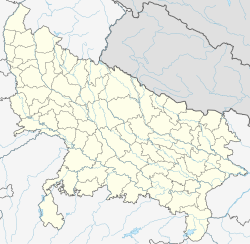Top Qs
Timeline
Chat
Perspective
Paronkh
Village in Uttar Pradesh, India From Wikipedia, the free encyclopedia
Remove ads
Paronkh (Paroṅkh) is a village in Mainpuri block of Mainpuri district, Uttar Pradesh. A minor battle took place here in 1562; it was the first time the Mughal emperor Akbar personally commanded troops in battle. There are ruins of an old fort in the village. As of 2011, Paronkh has a population of 2,413, in 411 households.
Remove ads
Geography
Paronkh is located on the Isan River,[3]: 251 10 km[1]: 147 southwest of Mainpuri. In the village there is a mound, or khera, with the ruins of an old fort.[3]: 251
History
Paronkh was the site of the Battle of Paronkh, in early 1562. This was a minor battle fought between a "punitive force" under the Mughal emperor Akbar, consisting of 200 men and 200 elephants, and a group of about 400 local brigands from a group of eight villages in pargana Sakit. The Akbarnama, written by Akbar's official court historian Abu'l-Fazl ibn Mubarak, contains a narrative account of the battle. [4]: 89–92 [3]: 251 Although it was a minor event, Paronkh is notable for being the first battle that Akbar personally led troops in.[4]: 91
Remove ads
Demographics
As of 2011, Paronkh had a population of 2,413, in 411 households.[2]: 107 This population was 53.4% male (1,289) and 46.6% female (1,124). The 0-6 age group numbered 386 (204 male and 182 female), or 16.0% of the total population. 402 residents were members of Scheduled Castes, or 16.7% of the total.[5]: 88–9
The 1981 census recorded Paronkh as having a population of 1,920 people, in 269 households.[1]: 146–7
The 1961 census recorded Paronkh as comprising 2 hamlets, with a total population of 1,147 people (622 male and 525 female), in 215 households and 209 physical houses. The area of the village was given as 927 acres.[6]: lxxx
Infrastructure
As of 2011, Paronkh had 1 primary school and 1 primary health centre. Drinking water was provided by tap, well, hand pump, and tube well; there were no public toilets. The village had a post office and public library, as well as at least some access to electricity for residential and agricultural purposes. Streets were made of both kachcha and pakka materials.[2]: 107–12
References
Wikiwand - on
Seamless Wikipedia browsing. On steroids.
Remove ads
